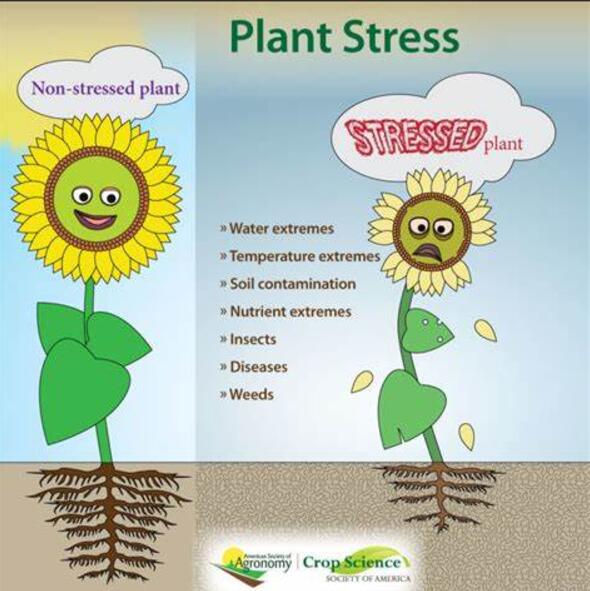Drought-mediated oxidative stress and its scavenging differ between citrus hybrids with medium and late fruit maturation
IF 6.8
Q1 PLANT SCIENCES
引用次数: 0
Abstract
Drought stress is a major environmental factor limiting citrus productivity. Still, differences in drought sensitivity between citrus hybrids of different maturation periods have so far not been reported. Here, we selected a medium-maturing (Fertile orange: FO (Citrus reticulata cv. Fertile orange) and a late-maturing citrus hybrid (Newhall Navel orange: NO (Citrus sinensis Osbeck cv. Newhall) and determined the physiological and biochemical traits of leaves, roots, wood and bark. Our results showed that drought significantly decreased net photosynthetic rate (Pn), stomatal conductance (Gs) and transpiration rate (Tr) of citrus leaves. Oxidative stress upon drought was indicated by enhanced foliar malondialdehyde (MDA) and hydrogen peroxide contents, as well as a stimulation of the anti-oxidative system. This stimulation included the contents of dehydroascorbic acid (DHA), glutathione (GSH) and oxidized glutathione (GSSG) in leaves, roots, wood and bark, as well as activities of antioxidative enzymes of glutathione reductase (GR), dehydroascorbate reductase (DHAR), superoxide dismutase (SOD) and peroxidase (POD). The late maturing NO hybrid not only showed better general physiological performance as indicated by increased Pn in leaves, but also higher biochemical ROS scavenging and osmotic capacity as indicated by increased ascorbic acids (ASA), DHA, and proline contents, as well as activities of enzymes of SOD, POD, ASA/DHA and GSH/GSSG ratios in the investigated tissues compared to the FO hybrid under drought and control conditions. Analysis of molecular mechanisms of signaling, regulatory and functional genes expression are suggested for future studies to elucidate the complex interplay of molecular, biochemical and physiological responses of citrus hybrids to drought.
中果期和晚果期柑橘杂交种在干旱介导的氧化应激及其清除能力方面的差异
干旱胁迫是限制柑橘产量的一个主要环境因素。但迄今为止,不同成熟期的柑橘杂交种对干旱敏感性的差异尚未见报道。在此,我们选择了一个中等成熟期的柑橘杂交种(Fertile orange:FO(Citrus reticulata cv. Fertile orange)和晚熟柑橘杂交种(Newhall Navel orange:NO (Citrus sinensis Osbeck cv. Newhall),并测定了叶、根、木质部和树皮的生理生化性状。结果表明,干旱会明显降低柑橘叶片的净光合速率(Pn)、气孔导度(Gs)和蒸腾速率(Tr)。干旱导致的氧化应激表现为叶片丙二醛(MDA)和过氧化氢含量增加,以及抗氧化系统受到刺激。这种刺激包括叶片、根、木材和树皮中脱氢抗坏血酸(DHA)、谷胱甘肽(GSH)和氧化谷胱甘肽(GSSG)的含量,以及谷胱甘肽还原酶(GR)、脱氢抗坏血酸还原酶(DHAR)、超氧化物歧化酶(SOD)和过氧化物酶(POD)等抗氧化酶的活性。与干旱和对照条件下的 FO 杂交种相比,晚熟 NO 杂交种不仅表现出更好的一般生理性能,如叶片中 Pn 的增加,而且表现出更高的生化 ROS 清除能力和渗透能力,如抗坏血酸(ASA)、DHA 和脯氨酸含量的增加,以及调查组织中 SOD、POD、ASA/DHA 和 GSH/GSSG 比率等酶的活性。建议在今后的研究中分析信号转导、调控和功能基因表达的分子机制,以阐明柑橘杂交种对干旱的分子、生化和生理反应的复杂相互作用。
本文章由计算机程序翻译,如有差异,请以英文原文为准。
求助全文
约1分钟内获得全文
求助全文
来源期刊

Plant Stress
PLANT SCIENCES-
CiteScore
5.20
自引率
8.00%
发文量
76
审稿时长
63 days
期刊介绍:
The journal Plant Stress deals with plant (or other photoautotrophs, such as algae, cyanobacteria and lichens) responses to abiotic and biotic stress factors that can result in limited growth and productivity. Such responses can be analyzed and described at a physiological, biochemical and molecular level. Experimental approaches/technologies aiming to improve growth and productivity with a potential for downstream validation under stress conditions will also be considered. Both fundamental and applied research manuscripts are welcome, provided that clear mechanistic hypotheses are made and descriptive approaches are avoided. In addition, high-quality review articles will also be considered, provided they follow a critical approach and stimulate thought for future research avenues.
Plant Stress welcomes high-quality manuscripts related (but not limited) to interactions between plants and:
Lack of water (drought) and excess (flooding),
Salinity stress,
Elevated temperature and/or low temperature (chilling and freezing),
Hypoxia and/or anoxia,
Mineral nutrient excess and/or deficiency,
Heavy metals and/or metalloids,
Plant priming (chemical, biological, physiological, nanomaterial, biostimulant) approaches for improved stress protection,
Viral, phytoplasma, bacterial and fungal plant-pathogen interactions.
The journal welcomes basic and applied research articles, as well as review articles and short communications. All submitted manuscripts will be subject to a thorough peer-reviewing process.
 求助内容:
求助内容: 应助结果提醒方式:
应助结果提醒方式:


